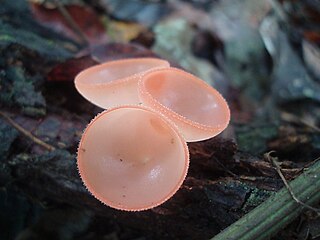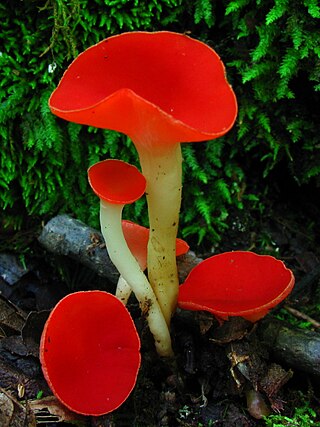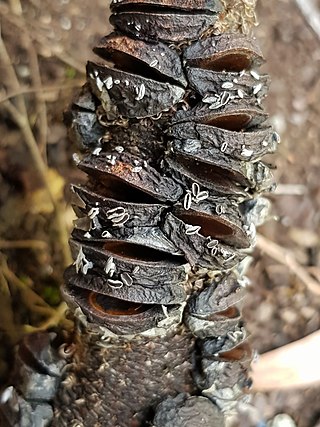
Helotiales is an order of the class Leotiomycetes within the division Ascomycota. The taxonomy within Helotiales has been debated. It has expanded significantly as genomic techniques for taxonomical identification have become more commonly used. As of February 2020, the order is estimated to contain 30 accepted families, 519 genera, and 6266 species.
Pseudopezicula tetraspora is a species of fungus in the family Helotiaceae. Found in North America, it is a plant pathogen that infects grape, causing a disease known as "angular leaf scorch".

The Orbiliaceae are a family of saprobic sac fungi. It is the only family in the monotypic class Orbiliomycetes and the monotypic order Orbiliales. The family was first described by John Axel Nannfeldt in 1932 and now contains 288 species in 12 genera. Members of this family have a widespread distribution, but are more prevalent in temperate regions. Some species in the Orbiliaceae are carnivorous fungi, and have evolved a number of specialized mechanisms to trap nematodes.

Cookeina is a genus of cup fungi in the family Sarcoscyphaceae, members of which may be found in tropical and subtropical regions of the world. Species may be found on fallen branches of angiosperms, trunks, and sometimes on fruits. The Temuans of Peninsular Malaysia are reported to use certain species from this genus as food, and also as a bait for fishing, where it is rubbed against the hook.

Chorioactis is a genus of fungi that contains the single species Chorioactis geaster. The mushroom is commonly known as the devil's cigar or the Texas star in the United States, while in Japan it is called kirinomitake (キリノミタケ). This extremely rare mushroom is notable for its unusual appearance and disjunct distribution; it is found only in select locales in Texas and Japan. The fruit body, which grows on the stumps or dead roots of cedar elms or dead oaks, somewhat resembles a dark brown or black cigar before it splits open radially into a starlike arrangement of four to seven leathery rays. The interior surface of the fruit body bears the spore-bearing tissue known as the hymenium, and is colored white to brown, depending on its age. The fruit body opening can be accompanied by a distinct hissing sound and the release of a smoky cloud of spores.
Lithoglypha is a fungal genus in the family Acarosporaceae. It is monotypic, containing the single species Lithoglypha aggregata, a saxicolous (rock-dwelling), crustose lichen found in South Africa.

Badimiella is a genus of lichen-forming fungi in the family Pilocarpaceae. It has two species of foliicolous (leaf-dwelling) lichens.
Aquamarina is a fungal genus in the class Dothideomycetes. It is a monotypic genus, containing the single marine species Aquamarina speciosa, originally found in North Carolina, and distributed in the Atlantic Coast of the United States. The bluish-green species fruits exclusively in the lower parts of dying culms of the saltmarsh plant Juncus roemerianus.
Korfiella is a fungal genus in the family Sarcosomataceae. A monotypic genus, it contains the single species Korfiella karnika, found in India and described as new to science in 1970.

Pseudoplectania is a genus of fungi in the family Sarcosomataceae. The genus contains 12 species. Pseudoplectania ryvardenii was described in 2012, while Pseudoplectania carranzae was transferred to the genus in 2013.

Ascocoryne sarcoides is a species of fungus in the family Helotiaceae. The species name is derived from the Greek sarkodes (fleshy). Formerly known as Coryne sarcoides, its taxonomical history has been complicated by the fact that it may adopt both sexual and asexual forms. Colloquially known as jelly drops or the purple jellydisc, this common fungus appears as a gelatinous mass of pinkish or purple-colored discs. Distributed widely in North America, Eurasia, and Oceania, A. sarcoides is a saprobic fungus and grows in clusters on the trunks and branches of a variety of dead woods. Field studies suggest that colonization by A. sarcoides of the heartwood of black spruce confers some resistance to further infection by rot-causing fungi. A. sarcoides contains the antibiotic compound ascocorynin, shown in the laboratory to inhibit the growth of several gram-positive bacteria.

Microstoma floccosum is a species in the cup fungus family Sarcoscyphaceae. It is recognizable by its deep funnel-shaped, scarlet-colored fruit bodies bearing white hairs on the exterior. Found in the United States and Asia, it grows on partially buried sticks and twigs of oak trees.

Wynnea americana, commonly known as moose antlers or rabbit ears, is a species of fungus in the family Sarcoscyphaceae. The uncommon species is recognizable by its spoon-shaped or rabbit ear–shaped fruit bodies that may reach up to 13 cm (5 in) tall. It has dark brown and warty outer surfaces, while the fertile spore-bearing inner surface is orange to pinkish to reddish brown. It is distinguished from other species in its genus by the pustules on the outer surface, and microscopically by the large asymmetrical longitudinally ribbed spores with a sharply pointed tip. The spores are made in structures called asci, which have thickened rings at one end that are capped by a hinged structure known as the operculum—a lid that opens to release spores from the ascus.

Sarcoscypha occidentalis, commonly known as the stalked scarlet cup or the western scarlet cup, is a species of fungus in the family Sarcoscyphaceae of the Pezizales order. Phylogenetic analysis has shown that it is most closely related to other Sarcoscypha species that contain large oil droplets in their spores. S. occidentalis has an imperfect form, classified as Molliardiomyces occidentalis.

Banksiamyces toomansis is a species of fungus in the family Helotiaceae. It was first described as Tympanis toomansis by Miles Joseph Berkeley and Christopher Edmund Broome in 1886, and transferred to the genus Encoelia in 1957 by R.W.G. Dennis. Gordon William Beaton transferred it to Banksiamyces in 1982.

Discinella terrestris is a species of fungus in the family Helotiaceae. It was first described as Helotium terrestre by Miles Joseph Berkeley and Christopher Edmund Broome in 1882, from collections made in Brisbane. R.W.G. Dennis transferred it to the genus Discinella in 1958.
Phyllachora banksiae is a species of fungus in the family Phyllachoraceae. Originally named Plectosphaera banksiae by Harry Swart, it was placed in the genus Phyllachora in 2001. The type collection was made from a Banksia integrifolia plant in Lake Tyers, Victoria (Australia) in May, 1986. Infection is characterised by leaf spots that have a greyish central area spotted with black ostioles (pores) through which spores are expelled. The mycelium of the fungus grows in the double-layered epidermis of the leaf of the host plant, and penetrates the mesophyll tissue in the center of the colony. Perithecia are up to 400 µm in diameter and are the same thickness as the leaf. The asci are up to 180 µm long and 15 µm wide. Ascospores are hyaline (translucent), and measure 20–25 by 10 µm.

Glutinoglossum glutinosum, commonly known as the viscid black earth tongue or the glutinous earthtongue, is a species of fungus in the family Geoglossaceae. Widely distributed in the Northern Hemisphere, it has been found in northern Africa, Asia, Europe, and North America. Although previously thought to exist in Australasia, collections made from these locations have since been referred to new species. G. glutinosum is a saprophytic species that grows on soil in moss or in grassy areas. The smooth, nearly black, club-shaped fruitbodies grow to heights ranging from 1.5 to 5 cm. The head is up to 0.7 cm (0.3 in) long, and the stipes are sticky. Several other black earth tongue species are quite similar in external appearance, and many can be reliably distinguished only by examining differences in microscopic characteristics, such as spores, asci, and paraphyses. First described in 1796 as a species of Geoglossum, the fungus has gone through several changes of genera in its taxonomic history. It was placed in its current genus, Glutinoglossum, in 2013.
Ascodesmis nigricans is a coprophilous fungus that could be isolated from the dung of various animals. It was firstly introduced by Philippe Édouard Léon Van Tieghem, a French botanist, and was the type species of the genus Ascodesmis. It is an uncommon species but its development of the fruit body has been the subject of much laboratory study due to the easy nature of its cultivation. Ascodesmis nigricans is not pathogenic to human, animals or plants. This species has world-wide distribution.
Brunneocarpos is a fungal genus in the family Mycocaliciaceae. It is a monotypic genus, containing the single species Brunneocarpos banksiae. The fungus grows on the cones of Banksia plants in Australia.















